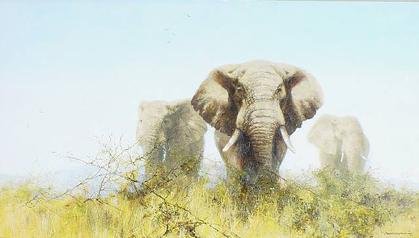This is the second in an occasional series and features the British artist, David Shepherd, (1931-2017)
I chose to feature his work because he has been a household name in the UK and his art has sold at high prices despite the fact that he chose to produce traditionally styled naturalistic paintings and was an outspoken critic of the mainstream art world and the various forms of modern art that have been taught in the art schools since the Second World War.
As a boy, I remember him being promoted on childrens' TV as an artist who painted steam trains and elephants but turned his hand to old fighter planes and African wildlife that might be termed 'big game' (if it weren't for the fact that was a campaigning environmentalist!). He did paint portraits as well, most notably the Queen Mother. He was decorated by the state - the UK government gave him a CBE and an OBE and was a Fellow of the Royal Society of Art. Although on his death, tributes were paid to him as a conservationist and as a pioneer of railway and steam train preservation rather than primarily as an artist. I never remember the main art critics of the day recommending his work.
Once again this indicates that regardless of what the critics of the art world say, there is a market for high-quality art. These artists succeeded despite the fact that their work was dismissed by the elite art world. He succeeded because the common sense of ordinary people is a better judge of what is good than all the critics in the world. I would say that it is easier to make it now than in his day, because there is a growing backlash against modernity that is beginning to make headway. At some point the mainstream art world will collapse, hollowed out from the inside and for years maintaining a facade of relevancy and power long beyond the point that it has any, just like Ottoman empire!
Some may wonder what this has to do with liturgy? My premise is that the liturgical forms of art are basis of the forms that permeate the whole of a Christian culture. I know nothing of David Shepherd's faith, but his work is consistent with a Christian worldview and the forms of authentic liturgical art of the past, whether he was aware of it or not. We need artists and culture creators who contribute to the culture from the wellspring of Christian culture, the liturgy, to the mundane. Each must contribute according to his interest and calling.
David Shepherd was born in Hendon, London on 25th April 1931. He attended Stowe School in Buckinghamshire. Shortly after leaving school, David traveled to Kenya wanting to become a game warden, but he was refused the post due to lack of experience. Upon returning to the UK David applied for a place at the Slade School of Art London but he was refused entry because he was judged to have no artistic ability. By chance, David met artist Robin Goodwin who agreed to teach David over a three-year period. This again conforms to the pattern of so many of these mavericks, who were trained outside art schools, or else are self-trained.
There is another interesting point here. Over the years when I was discerning, I would ask good spiritual directors about my desire to be an artist. Each of them asked me my reasons for being an artist but none asked me if I was any good at painting. I asked one of them years later why this was and he said to me that if you love what you paint, you will always find a way to get the skill. This is why artists specialize in particular subjects. It is not so much that they find those subjects easier to paint, rather, it is that they are more inclined to paint what they love and motivated to do those things well. If what they paint is good, and they paint well, then their work will be beautiful.








